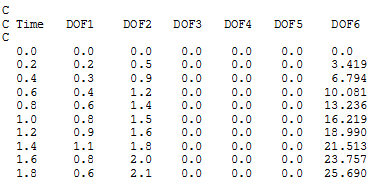*Vessel Timetrace
To specify that the combined high and low frequency motions of a vessel are to be read from an ASCII timetrace data file.
Refer to Combined High and Low Frequency Motion Timetraces for further information on this feature.
A block of two lines repeated as many times as necessary to define motions for all appropriate vessels.
VESSEL=Vessel Name [, OPTION=Axis System]
FILE=File Name
Data for any Vessel Name specified here must be input under *VESSEL. As this keyword is used to specify that both high and low frequency vessel motions are to be read from a text file, it may not be used in combination with *RAO or *DRIFT for any particular vessel. Axis System can be GLOBAL (the default) or LOCAL. File Name should include the entire path of the vessel timetrace motion file including its extension. If the file name or any part of its path contains spaces then it should be enclosed in double quotation marks.
Input: |
Description |
Vessel: |
The name of the vessel for which combined motion data is being input. |
Timetrace File Name: |
The name of the ASCII data file containing the timetrace of the motion of the vessel reference point. Timetrace File Name should ideally include the entire path of the vessel drift motion file, including extension. If the name or any part of its path contains spaces, the full Timetrace File Name should be enclosed in double quotation marks (" "). The required format of the data file is described in Note (a). |
Axis Type: |
The options are Global (the default) and Local. |
(a)The format of the ASCII vessel motion timetrace file is as follows. The file contains seven columns of data. The first column contains time data, and the remaining six correspond to displacements of the reference point in six degrees of freedom. Comment lines, denoted by a capital ‘C’ in the first column, are permitted, while lines that are completely blank are ignored. An example data file extract is shown below.

The first column of data contains time values. Columns 2 – 4 contain the displacements (not coordinates) of the reference point from its initial position at the start of the dynamic analysis. This means that the data in the timetrace file should not include the value of any static offset you apply to the vessel. If it does, what will happen is that the offset will be applied twice. These displacements are in either the global XYZ axes or else in a local axis system defined by the initial orientation of the vessel – you specify which using the Vessel Motions – Axis Type option. Columns 5 – 7 contain rotations in degrees. Column 5 contains the yaw rotation of the vessel about the vertical or global X axis. Columns 6 and 7 are roll and pitch respectively, relative to either the yawed or initial vessel axes, depending on whether large or small angle theory is specified. Note that each line of the file (other than comment lines or blank lines) must contain 7 numerical values.
Flexcom uses cubic spline interpolation to find the displacements and rotations of the reference point at times intermediate to those specified in the data file (for this reason the analysis solution times do not need to match those in the data file).
(b)For analysis times before the earliest time specified in the data file, Flexcom uses the values at that earliest time until the analysis time exceeds this value. Similarly, for analysis times after the latest time in the data file, Flexcom uses the values at that latest time.
(c)The choice of axis system refers to data you specify for vessel timetrace motions. Motions in this context means translations only – rotations always refer to vessel axes. Naturally Global stipulates that translations represent drift or combined motions in any or all of the global X, Y or Z axes, and/or that the angle you specify in defining a constant velocity is relative to global Y. Conversely Local indicates that translations represent any or all of heave, surge or sway, defined with reference to the initial orientation of the vessel axes, or that the angle you specify in defining a constant vessel velocity is relative to the vessel surge axis.
(d)Vessel motions are normally due to wave excitation. If you apply a time history of vessel motion, then you must ensure that you also specify the corresponding wave excitation which generated those vessel motions. This is typically specified via a Time History of Water Surface Elevation.